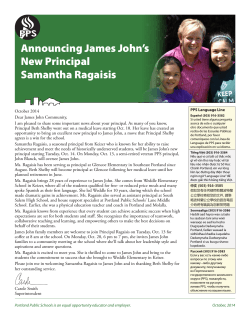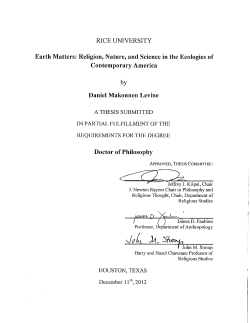
A History of Eagle Point
A History of Eagle Point: From John Muir to John Kenward Besides being a spectacular site, Eagle Point has a fascinating history. The property adjoins Terwilliger Parkway to the east and straddles the original Donation Land Claims of Elizabeth Thomas Caruthers (north) and James and Philinda Terwilliger (south); Lowell St. was the dividing line between the old claims. John Muir bought 10 acres of Caruthers Addition in 1883, including Eagle Point, and built a house for his family nearer to the river below. This was not the same John Muir of Yosemite fame. Rather, this was “John Muir of Wall Street” who at the time was an executive with the Oregon Railroad & Navigation Company/Northern Paci\ic Railroad and a protégé of Henry Villard. John Muir of Yosemite made occasional visits to Portland to lecture and promote conservation of Mt. Rainier and Crater Lake, and on one of those visits he dined with his Portland namesake who had also emigrated from Scotland. Muir moved to New York City in 1886 and eventually became a director of the New York Stock Exchange. His biography is titled “John Muir of Wall Street: A Story of Thrift” by O.M. Fuller, Knickerbocker Press, 1927. Eagle Point was sub-‐divided around 1891 and named “First Street Terraces”. In 1893 an illustrator named Frederick Walpole purchased the entire subdivision. Walpole was employed by the U.S. National Herbarium (now National Museum of Natural History) and traveled around the Northwest making botanical illustrations. He was one of several naturalists that went on the 1899-‐1900 E.H. Harriman expeditions to Alaska that also included John Muir (of Yosemite) and John Burroughs. 800 of his illustrations are owned by the Smithsonian Institution and on inde\inite loan to the Hunt Institute for Botanical Illustration at Carnegie Mellon University. More information about Walpole and samples of his beautifully detailed drawings can be seen here: http://www.huntbotanical.org/ art/show.php?13 Walpole constructed a modest shingle style house on the top of the knoll that included a windmill. He was reported to be a fan of the writings of John Ruskin, which was re\lected in the honest expression of his house. After he died of typhoid in 1904 the property went to his sister, Marian, and her husband Theodore Burkhart, and it stayed in their family until the 1960s. An article in the June 12, 1904 Sunday Oregonian prominently featured the Walpole/Burkhart home which they called “Ceanothus Knoll”, so named for “an enormous growth” of ceanothus with “feathery white blooms” on the premises. On the reverse side of this feature page was another illustrated feature of “Mr. Olmsted’s Plan for Parks, Parkways, and Boulevards”. Indeed, 1904 was the year that the Olmsted Brother’s master plan for Portland parks was introduced. The master plan called for a “South Hillside Parkway”, and by 1912 much of the property for the parkway had been donated or acquired and plans had been drawn up. Those plans showed the parkway encircling Eagle Point and listed 4.3 acres at Eagle Point as an “Area of Unacquired Portions”. Eagle Point was never acquired because of lack of funds. One can imagine that the Burkharts were quite happy where they were and not willing to sell for the city’s price. Nevertheless, in 1921 the Burkharts dedicated to the city a roadway around Eagle Point along with a parcel below it for a scenic loop and viewpoint that partly ful\illed the Olmsted vision for Eagle Point. Although the loop road was graded it appears that it was not further developed or maintained because in 1963 the city allowed a portion of it to be vacated to adjacent property owners. -‐ from Terwilliger Parkway Corridor Plan, 1983 In the 1960s the Burkharts sold their remaining 1-‐acre hilltop property and house to John and Mary Jane Kenward. John Kenward was the \irst [director] of the newly created Portland Development Commission and played a leading role in the city’s urban renewal program in the 1960s. He led the redevelopment of the South Auditorium Renewal Area and was instrumental in bringing landscape architect Lawrence Halprin to Portland to design the highly successful parks, walkways, and fountains of that area. In 2013, several years after John and Mary Jane had passed away, their heirs sold the property to Portland Parks and Recreation. Friends of Terwilliger had been in communication with the Kenwards since 2000 about the future of their property and our desire to see it preserved; we are fortunate that the Kenwards were interested in preserving it and that Portland Parks was in a position to purchase it. Thus, a one hundred year old vision to make Eagle Point a part of Terwilliger Parkway was \inally realized. We are also extremely fortunate that both the Walpole/Burkharts and the Kenwards were good stewards of their unique property and sought to preserve its natural character rather than developing it to its fullest potential.
© Copyright 2025

















